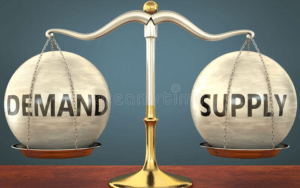The relationship between quantity of goods or services that producers want to sell at different prices and the quantity consumers want to buy is known as supply and demand, and it is used to determine prices in economic theory. By understanding how supply and demand interact in a market and how they are affected by space, we can effectively forecast and control their results to efficiently manage the economy. Allow me to demonstrate:
Demand for a certain commodity is influenced by its price as well as potentially a wide range of other factors – including consumer income, consumer preference, and seasonal impacts. Basic economic analysis entails studying the relationship between several price levels and the maximum quantity that consumers might possibly purchase at each of those prices, while frequently holding all other variables constant.

Source: https://www.dreamstime.com
Consumers are people who reside in a particular area; these locations can be connected to their income, preferences and seasonality. When using GIS to analyse the relationship between price levels and quantity demanded, it is possible to identify which consumers are willing to purchase goods at what price without controlling variables like income, consumer or seasonality. GIS may show situations as they actually are, with details indicating where to go for solutions.
In economics, the price-quantity combinations can be shown on a demand curve, where the horizontal axis represents quantity and the vertical axis represents price. A demand curve usually slopes downward, demonstrating consumers’ willingness to buy more of the goods at lower prices.
Showing the relationship between price and quantity on an x-y plane can lead to assumptions that may not be accurate. This is because the relationship between price and quantity is complex and can be influenced by various factors; such as consumer preferences, income levels and nature of the good itself.
For example, a downward-sloping demand curve does not necessarily mean that consumers are willing to buy more goods at a lower price. It could also be that the number of consumers who can afford the goods at that price has increased; or that consumers are buying more in anticipation of future higher prices.
Additionally, certain goods – such as luxury goods or perishable goods – may not follow the typical relationship between price and quantity, as consumer behaviour towards such goods can be different.
GIS can help to understand these dynamics by mapping the relationship between price and quantity in space, and identifying areas where people are willing to buy certain goods at certain prices. This can be useful for determining how to set prices for perishable goods, such that they can be sold without going to waste due to low prices.
In economics, the relationship between a good’s price and its quantity supplied or demanded is not always straightforward. While an increase in price typically leads to a decrease in demand and an increase in supply, the extent of these changes can vary greatly depending on the product and market conditions. To better understand this relationship, economists use the concept of price elasticity – which is a measure of how responsive supply and demand are to changes in price.
However, it’s important to note that these assumptions may not always hold true, as markets are constantly changing and products may be in surplus in one area while in high demand in another. This is where GIS comes in as a valuable tool in understanding the complex dynamics of price and quantity.
By mapping the relationship between price and quantity in space, GIS can identify areas where demand is high and supply is low; thus allowing for more efficient distribution and pricing of goods. Additionally, GIS can help to identify areas where surplus goods are available – preventing waste and ensuring that resources are allocated where they are most needed. In this way, GIS can play a crucial role in achieving price equilibrium and ensuring that goods are distributed in a fair and efficient manner.
In conclusion, a key idea in economics that affects how much products and services cost in a market is the link between supply and demand. However, there are several variables that can affect the link between price and quantity – including customer preferences, income levels and characteristics of the commodity itself.
By mapping the relationship between price and quantity in location, a geographic information system (GIS) is a useful tool for understanding the dynamics of supply and demand. It can pinpoint regions with strong demand but little supply, enabling more effective product distribution and pricing. In order to achieve price equilibrium and effectively manage the economy, GIS can play a critical role.
>>>the writer is the founder of Where Geospatial and is currently president of Where Geospatial Media, a not for profit organisation whose vision is to establish a geospatial ecosystem that aids development by utilising geospatial technologies. Professionally, he works as a GIS Solutions Engineer – assisting clients to integrate GIS technologies into their work processes and increase productivity through training and technical support. He occasionally publishes some of his thoughts in blogs. Email: [email protected]; LinkedIn: linkedin.com/in/francis-andorful-2442a791; Mobile: +233542507038










